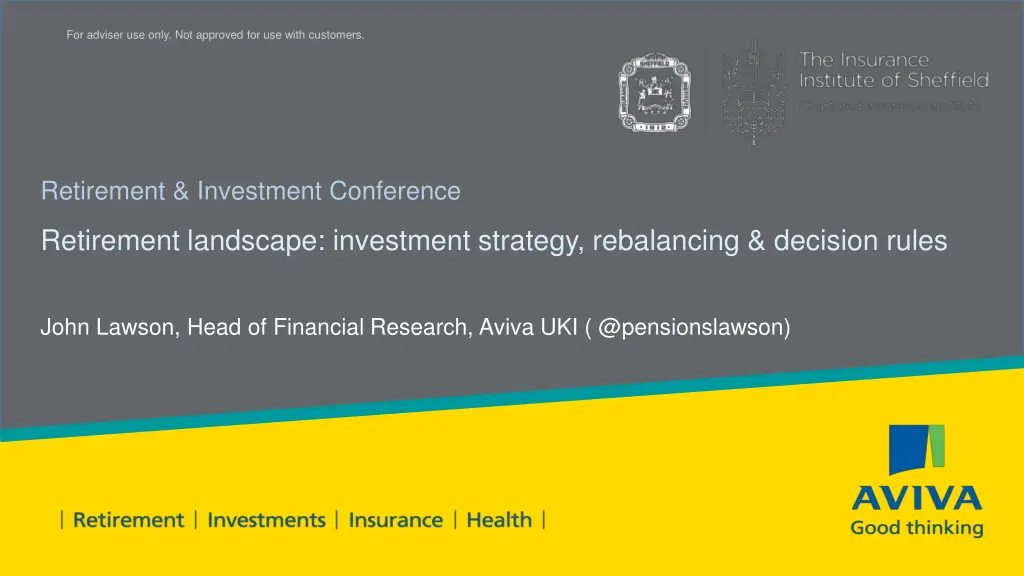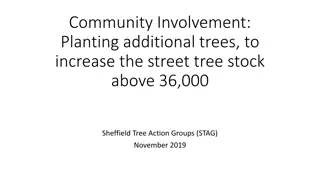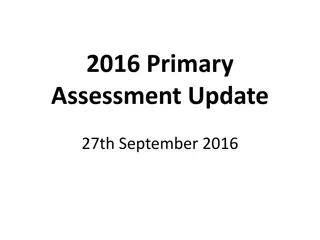
Retirement Investment Strategies: Key Insights & Decision Rules
Explore essential topics such as sustainable income, rebalancing, decision rules, and success rates in retirement investment strategies. Learn about the 4% rule, success rates by initial draw, equity content, and passive strategies to optimize your retirement planning.
Download Presentation

Please find below an Image/Link to download the presentation.
The content on the website is provided AS IS for your information and personal use only. It may not be sold, licensed, or shared on other websites without obtaining consent from the author. If you encounter any issues during the download, it is possible that the publisher has removed the file from their server.
You are allowed to download the files provided on this website for personal or commercial use, subject to the condition that they are used lawfully. All files are the property of their respective owners.
The content on the website is provided AS IS for your information and personal use only. It may not be sold, licensed, or shared on other websites without obtaining consent from the author.
E N D
Presentation Transcript
For adviser use only. Not approved for use with customers. Retirement & Investment Conference Retirement landscape: investment strategy, rebalancing & decision rules John Lawson, Head of Financial Research, Aviva UKI ( @pensionslawson) Aviva: Public
Talking points Sustainable income best asset mix Does rebalancing actually work? Decision rules versus rebalancing Aviva: Public
But first, some assumptions Aviva s own research Data source: Barclays Equity Gilt Study annual returns from 1900 - 2017 Gives 88 * 30 year periods Analysis is based on UK returns on equities, gilts and cash Annual (rather than monthly) income withdrawals 1% pa charge assumed A 30-year retirement is assumed These figures are illustrations of what might have happened in the past Aviva: Public
The 4% rule? 4% initial draw with inflationary rises considered safe for a 30 year retirement Based on analysis of US historic returns e.g. Bengen, 1994 (50/50 stocks and bonds portfolio, inflation-linked draws, 30 year horizon and zero charge) UK historic returns would suggest a lower safe rate of c.2.5% (1% charge) An inflation-linked annuity is currently c.2.7% The lowest draw we consider in this work is 3.5%, on the assumption that the key aim is to increase income alongside leaving a possible inheritance Aviva: Public
Success rates by initial draw and equity content, with inflation-linked draw and 30-year retirement, passive strategy 0% equity 40% equity 80% equity 10% equity 50% equity 90% equity 20% equity 60% equity 100% equity 30% equity 70% equity 95% 85% 75% Success rate 65% 55% 45% 35% 25% 15% 3.50% 4.00% 4.50% Draw rate 5.00% 5.50% Aviva: Public
Success rates by initial draw and equity content: inflation-linked, no cap v 5% cap, 30-year retirement, passive strategy 5% cap - 50% equity 5% cap - 60% equity 5% cap - 70% equity 5% cap - 80% equity no cap - 50% equity no cap - 60% equity no cap - 70% equity no cap - 80% equity 100% 95% 90% 85% Success rate 80% 75% 70% 65% 60% 55% 50% 3.50% 4.00% 4.50% Draw rate 5.00% 5.50% Aviva: Public
Success rates by initial draw and equity content: 5% capped inflation v level, 30-year retirement, passive strategy 100% 95% 90% 85% Success rate 80% 75% 70% 65% 5% cap - 50% equity 5% cap - 60% equity 5% cap - 70% equity 5% cap - 80% equity level - 50% equity level - 60% equity level - 70% equity level - 80% equity 60% 55% 50% 3.50% 4.00% 4.50% Draw rate 5.00% 5.50% Aviva: Public
Passive or rebalance? 50% equity, 4% income withdrawal 30YR, 50%EQUITY40%GILTS10%CASH, 4% DRAW, INFLATION- LINKED WITH 5% CAP 450,000 FUND VALUE, Y, AFTER 30 YEARS PASSIVE REBALANCE 400,000 350,000 300,000 250,000 200,000 150,000 100,000 50,000 - PERCENTAGE OF START YEARS WHERE FUND VALUE WAS AT LEAST Y AFTER 30 YEARS Aviva: Public
Passive or rebalance? 80% equity, 4% income withdrawal 30YR, 80%EQUITY10%GILTS10%CASH, 4% DRAW, INFLATION- LINKED WITH 5% CAP 600,000 FUND VALUE, Y, AFTER 30 YEARS PASSIVE REBALANCE 500,000 400,000 300,000 200,000 100,000 0 PERCENTAGE OF START YEARS WHERE FUND VALUE WAS AT LEAST Y AFTER 30 YEARS Aviva: Public
Retiring on 1stJanuary 1973 7.0% draw, with inflation-linked rises capped at 5% Choose 80% equity, 10% gilt, 10% cash mix But 1973 saw equity losses of 28% followed by losses of 50% in 1974 Drawing from the equity pot in 1973 and 1974 massively erodes capital But 1975 saw 150% equity growth unless you rebalanced back towards equity then you missed out on a lot of this and the high yields of the 80s and 90s In this example, the passive fund runs out in the 19th year, whereas the rebalancing approach lasts 30 years This is an extreme example to show the impacts of missing out on good equity returns! Aviva: Public
Retiring on 1stJanuary 1973 PASSIVE 100,000 80,000 FUND VALUE 60,000 40,000 20,000 - 0 2 4 6 8 10 YEAR OF PROJECTION 12 14 16 18 20 22 24 26 28 30 -20,000 UK equity BarCap UK cash BarCap CUMULATIVE DRAWS UK gilts BarCap FUND VALUE Yield Aviva: Public
Retiring on 1stJanuary 1973 REBALANCE 100,000 80,000 FUNDS VALUE 60,000 40,000 1,461 20,000 - 0 2 4 6 8 10 12 14 16 18 20 22 24 26 28 30 -20,000 YEAR OF PROJECTION UK equity BarCap UK cash BarCap CUMULATIVE DRAWS UK gilts BarCap FUND VALUE Yield Aviva: Public
Guyton and Klinger Portfolio Rule Portfolio Rule: Following a year where positive return achieved such that equities or bonds exceeds target weighting, sell excess and place in cash to meet future withdrawals Income withdrawals funded in order: 1) Overweighting in equity assets from prior year end, 2) Overweighting in fixed income from prior year end 3) Cash 4) withdrawals from remaining fixed income and 5) withdrawals from remaining equity assets in order of prior year s performance No withdrawals are taken from any equity following a year of negative returns if cash or fixed income assets are sufficient to cover withdrawals Aviva: Public
Guyton and Klinger Portfolio Rule - 1973 1973: RULES 120,000 100,000 80,000 FUND VALUE 60,000 30,973 28,857 13,293 40,000 20,000 - 0 1 2 3 4 5 6 7 8 9 10 11 12 13 14 15 16 17 18 19 20 21 22 23 24 25 26 27 28 29 30 -20,000 YEAR OF PROJECTION UK equity BarCap UK cash BarCap CUMULATIVE DRAWS UK gilts BarCap FUND VALUE Yield Aviva: Public
Rules or rebalancing? 30YR, 80%EQUITY10%GILTS10%CASH, 4% DRAW, INFLATION- LINKED WITH 5% CAP FUND VALUE, Y, AFTER 30 YEARS 600,000 REBALANCE RULES PASSIVE 500,000 400,000 300,000 200,000 100,000 0 PERCENTAGE OF START YEARS WHERE FUND VALUE WAS AT LEAST Y AFTER 30 YEARS Aviva: Public
Rules summary Some promising initial findings Offer some protection when more risk is taken Offers greater protection when overall portfolio returns are lower Largely perform better than rebalancing At higher equity contents perform similarly or slightly better than a passive strategy BUT so far we have looked only at UK historic returns and one risky asset (equities) => important to not make generalisations as very limited data set Aviva: Public






















